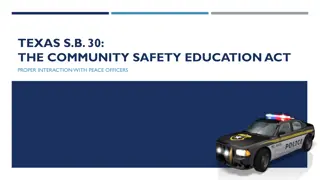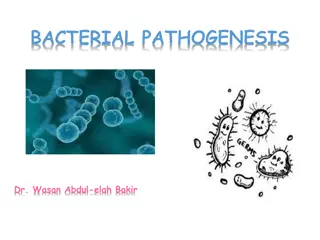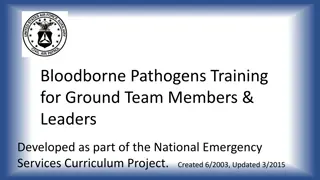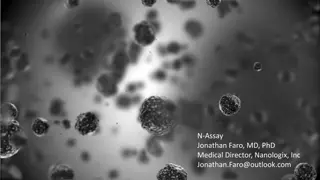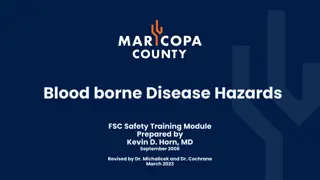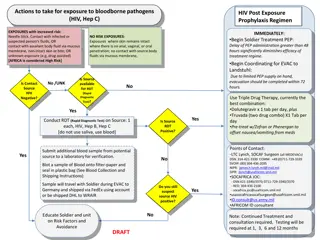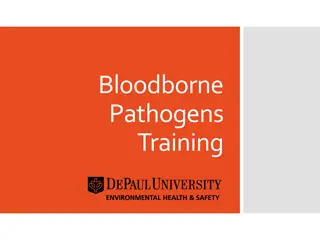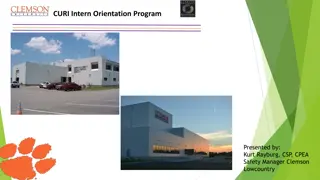Bloodborne Pathogens Training for Public Safety Officers & Sergeants
Bloodborne pathogens (BBPs) are pathogenic microorganisms found in human blood that can cause diseases like HIV, Hepatitis B, and Hepatitis C. Public safety officers and sergeants face occupational exposure to BBPs and should follow OSHA's BBP Standard to protect themselves. Training, vaccinations, and written exposure control plans are essential in minimizing risks associated with BBPs. Access the full OSHA BBP Standard for detailed guidelines and DePaul's Exposure Control Plan for specific protocols.
Download Presentation

Please find below an Image/Link to download the presentation.
The content on the website is provided AS IS for your information and personal use only. It may not be sold, licensed, or shared on other websites without obtaining consent from the author.If you encounter any issues during the download, it is possible that the publisher has removed the file from their server.
You are allowed to download the files provided on this website for personal or commercial use, subject to the condition that they are used lawfully. All files are the property of their respective owners.
The content on the website is provided AS IS for your information and personal use only. It may not be sold, licensed, or shared on other websites without obtaining consent from the author.
E N D
Presentation Transcript
BLOODBORNE PATHOGENS TRAINING for Public Safety Officers & Sergeants
WHAT ARE BBPs? Bloodborne pathogens, or BBPs for short, are pathogenic microorganisms present in human blood that can cause disease in humans. The BBPs we are most concerned about in the US are: Human Immunodeficiency Virus (HIV) Hepatitis B Virus Hepatitis C Virus
OTHER POTENTIALLY INFECTIOUS MATERIALS (OPIM) Other than blood, certain body fluids can also carry BBPs. OSHA calls these other potentially infectious materials, or OPIM. These are mainly internal body fluids that you are very unlikely to encounter. More common fluids like urine,vomit, sweat, tears and saliva are not OPIM and thus pose no BBP risk unless they also contain visible blood. That being said, it s best to treat all body fluids as potentially contaminated and stay away from them! OSHA = Occupational Safety and Health Administration
YOUR OCCUPATIONAL EXPOSURE Since your job duties include assisting and transporting injured people, and responding to unique situations anything from a drug overdose to dealing with a person who could become violent we consider you to have occupational exposure to bloodborne pathogens. This is another OSHA term that means you have reasonably anticipated contact with blood and OPIM at work.
OSHAS BBP STANDARD Speaking of OSHA, their BBP Standard is where all of these requirements come from. The standard is designed to protect employees like you that have occupational exposure. It requires that you be trained about BBPs annually and be offered the hepatitis B vaccination free of charge. It also requires that any medical treatment you need as a result of exposure to BBPs at work be covered by DePaul. It also requires us to have a written Exposure Control Plan which outlines how we minimize or eliminate these risks for our employees.
ACCESS You can access the full text of OSHA s BBP Standard at: https://www.osha.gov/pls/oshaweb/owadisp.show_document? p_id=10051&p_table=STANDARDS You can view DePaul s written Exposure Control Plan: in LPC, located in the information binder. in the Loop, posted on the dispatch bulletin board.
BLOODBORNE DISEASES Before we get into how to protect ourselves from BBPs, let s review the diseases they can cause.
HIV Human Immunodeficiency Virus (HIV) attacks the immune system. Some people develop flu-like symptoms initially, but many do not experience any symptoms. The virus can lay dormant for a decade or more (but does not always). If untreated, it will progress to Aquired Immunodeficiency Syndrome (AIDS). These days, HIV carriers can live nearly as long as those without it, as long as they receive treatment before it progresses. The only way to know if you have HIV is by blood test.
HEPATITIS B & C Hep B and C are similar viruses that affect the liver. Like HIV, many people show no symptoms. If they do, they can include fever, fatigue, loss of appetite, upset stomach, and vomiting, which can easily be confused with minor illnesses. Some stranger symptoms are dark urine, gray stools, joint pain, and jaundice (yellowing of the skin/eyes). Sometimes the virus goes away without treatment. This is much more likely to happen with Hep B. Some will develop a chronic (lifelong) infection which can cause cirrhosis (scarring) of the liver, liver cancer, or even death. About 5% of adults with Hep B will develop the chronic version. For Hep C, it will become chronic for 70-85% of people. There are more and better treatment options available today for both chronic Hep B and C. The only way to know if you have either virus is by blood test.
HEPATITIS B VACCINATION A major difference between Hepatitis B and C is that there is a safe and effective vaccine available for Hepatitis B! Again, this is available to you free of charge because of your occupational exposure. The vaccination is a series of 3 shots in the arm over the course of 6 months. It is a yeast-based vaccine, so it contains no live virus. More than 90% of people who get vaccinated develop immunity, and this immunity is thought to last 20-30 years (studies are ongoing about this).
HOW DO BBPs SPREAD FROM PERSON TO PERSON? In order for this to be possible, an exposure incident must occur. An exposure incident is when an infected person s blood enters the bloodstream of another person. In the workplace, this can happen in 3 ways: By puncture with a contaminated object (getting stuck with a used needle) Through non-intact skin (any area of broken skin: cuts, rashes, acne, etc.) Through mucous membranes (the tissues of your eyes, nose and mouth)
BBPs are NOT spread by casual contact like shaking hands, hugging, drinking from the same glass, or using the same toilet. BBPs are NOT spread through the air, so coughing and sneezing are not a concern.
EXPOSURE DISEASE It s important to note that just because an exposure incident occurs doesn t mean that infection (and thus, disease) will. In fact, the chance of you getting a bloodborne disease from a typical workplace incident is actually very low.
RECOGNIZING EXPOSURE INCIDENTS
As Public Safety officers and sergeants, you are the University s first point of contact for any exposure incidents that do occur (unless it is a 911 emergency situation). This is written in our Exposure Control Plan, and other departments are trained to report exposure incidents to Public Safety. Because of this, it s important that you be able to identify what is and is not an exposure incident.
You will now be presented with 6 different scenarios. Please read each scenario and think about whether it is an exposure incident or not, before clicking through. The slide immediately following each scenario will tell you the answer. Remember, there s no point in cheating here. It s part of your job to be able to identify exposure incidents.
SCENARIO 1: You see a coworker cut their finger.
Not an exposure incident. In order for this to be an exposure incident, the blood from their cut would have to come into contact with an area of non-intact skin or your mucous membranes.
SCENARIO 2: You shake hands with someone you know has HIV.
Not an exposure incident. BBPs are not spread through casual contact, like shaking hands.
SCENARIO 3: You help a student with a bleeding injury walk to your car, and some of their blood gets on a small cut on your hand.
Exposure incident! The student s blood came into contact with your non-intact skin (the small cut).
SCENARIO 4: You find a needle in a bathroom and use the new procedure to collect it safely.
Not an exposure incident. Using the new procedure, you will handle the needle with tongs. This would only be an exposure incident if you stuck yourself with the needle.
SCENARIO 5: You step in some vomit on the sidewalk, and you think you see blood in it.
Not an exposure incident. Unless you were walking around campus barefoot (don t do that!) and had cuts/other non-intact skin on your feet, this is not an exposure incident.
SCENARIO 6: While wearing gloves, you accidentally touch a surface that an injured employee bled on.
Not an exposure incident. The gloves protect you from contacting the employee s blood.
Now that youre an expert in identifying exposure incidents, let s talk about how to prevent them from happening in the first place.
UNIVERSAL PRECAUTIONS The most important thing you can do to prevent exposures is to practice universal precautions. This is just a fancy way of saying you treat all blood and body fluids as if they contain BBPs. In practice, this means: Do not get too close to injured person or accident scene Do not attempt to provide first aid beyond your training Warn others if they are getting too close or attempting to provide first aid, as they may not be aware of the risks Respond promptly and appropriately to situations that could lead to an exposure
SITUATIONS LIKE Blood or body fluid spills Items contaminated with blood or body fluids A needle found on campus
SPILLS & CONTAMINATED ITEMS Blood/body fluid spills and any items contaminated with them must be cleaned and decontaminated promptly. If you encounter them, secure the area and immediately notify Facility Operations. Our custodians are trained to handle these cases.
NEEDLE FOUND ON CAMPUS Click here for a video demonstration (subtitles are available if needed click the button)
FOUND NEEDLE PROCEDURE 1. 2. Secure the area. Retrieve needle collection kit from dispatch or Public Safety vehicle. Put on gloves. Place sharps container, lid open, on the ground or other stable surface next to the needle. Use tongs to pick up the needle with the sharp end facing away from you. Place into container sharp end first. You may also add any related items (wrapper, etc.) to the container, if present. Close the lid and secure with tape. 8. Use an alcohol wipe to disinfect the tongs where they touched the needle. Place in regular trash. Remove gloves and place in regular trash. 10. Wash your hands with hot water and soap. If a sink is not immediately available, use hand sanitizer and find a sink as soon as possible. 11. Bring the container back to dispatch and place in the biohazardous waste container. 12. Alert management that a new sharps container is needed. 13. Write up a report describing what happened. 3. 4. 9. 5. 6. 7.
BE AWARE There are biohazardous waste and sharps containers around campus. You can tell from the red coloring and Biohazard symbol Items in these containers are potentially infectious. Do not touch, open, or move these containers. If you see anything like this that looks out of place or otherwise suspicious, please notify EHS at (773) 325-3344.
If an exposure incident does occur, you must follow the steps on the next slide.
EXPOSURE INCIDENT RESPONSE 1. Ensure the exposed area is flushed with large amounts of water (and soap if contact was made with skin don t put soap in eyes or nose) 2. Transport the exposed person to the nearest emergency room for post-exposure evaluation 3. If a source individual (the person whose blood got on the exposed person) is identified and agrees, they should also be transported for evaluation 4. Take report (collecting as much information as possible) which will be sent to EHS
EHS is responsible for ensuring our OSHA obligations are met throughout this process. EHS will also coordinate payment for the ER visit and any needed follow up.
GENERAL ORDER The procedures covered on the previous slides for responding to blood/body fluid spills or contaminated items, found needles, and exposure incidents have been made into a general order.
RESOURCES Human Immunodeficiency Virus (HIV): www.cdc.gov/hiv Hepatitis B: www.cdc.gov/hepatitis/hbv Hepatitis B vaccination: www.cdc.gov/vaccines/vpd/hepb/index.html Hepatitis C: www.cdc.gov/hepatitis/hcv/ Please contact EHS at any time with questions! ehsoffice@depaul.edu (773) 325-3344 ehs.depaul.edu



